The Alphacool NexXxoS Cool Answer 360 DDC/XT Liquid Cooling Kit Review
by E. Fylladitakis on October 24, 2016 9:30 AM ESTInstallation
Casual users often wonder about how much harder the installation of a kit is over a AIO solution or even an air cooler. Actually, the installation itself is not very complex – the selection of the proper parts is. As the NexXxoS Cool Answer 360 DDC/XT is a full liquid cooling kit, it gives us the chance to demonstrate the installation process and highlight some of the most critical difficulties.
The first step is to install the liquid cooling block onto the CPU. Due to the size and the design of the block, this may be a very easy process, even easier than the installation of a simple air cooler. The Alphacool XP3 Light is a very easy to install block. Once the backplate with the support screws is attached to the rear of the motherboard, the block is simply fastened on the CPU using the thumbscrews and springs.
A critical issue when selecting liquid cooling parts is the selection of a proper radiator. A larger radiator will not necessarily improve performance, especially if the pump is weak and it can easily cause compatibility issues. In our case, we do have a powerful pump and the kit is configured with maximum performance and expandability in mind, so the XT45 radiator is a judicious choice.
It is however so thick that we could not fit it even in the Phantecs Enthoo Pro, a case specifically designed to support large radiators, just because the third fan was interfering with the extruding motherboard’s heatsinks. This might not have been an issue if we simply chose another motherboard with different heatsinks/layout. When selecting a high performance radiator, it is critical to take into account both the clearance of the case and the possible interference from other hardware parts.
The joined 5.25” bay reservoir and pump assembly does increase the ease of installation significantly. A stand-alone pump and reservoir would require the user to seek his/her own mounting space and methods. The placement of a reservoir in a 5.25” bay may seem very easy and straightforward, but there is a small catch; you cannot actually access the filling hole while the reservoir is inside the bay. As the reservoir needs to be pulled at least partially outside of the case, the user needs to make sure that the tubing is long enough to allow for it. For a fully clear reservoir, it is a pity that it does not have any lighting or direct support for external lighting options. This will not be an issue in a well-lit system though.
We should note that the Repack reservoir did not actually fit into the Enthoo Pro directly, as the body of the reservoir would not fit in between the side 5.25” device support tabs of the chassis. We had to bend two of the tabs out of the way in order for the reservoir to slide into a 5.25” bay. In order to effortlessly fit into any case, it should vertically have a slightly narrower body than its front faceplate, exactly like 5.25” devices do.
Once fully assembled, the liquid cooling setup looks very tidy and futuristic, having the system standing out from the appearance of a typical PC. When everything has been double-checked and tightened well (by hand, tools will damage most of these parts), it is time to fire up the PSU and fill the system with liquid. Note that the PSU needs to be disconnected from all of the system’s devices during this process, especially the motherboard. Alphacool provides a connector for the PSU that will start it without having to connect it to a motherboard, allowing to calmly fill the kit with liquid and check for leaks. Do not attempt to fill the kit with liquid by powering on the main system even if you are certain that there are no leaks because the CPU will overheat and risk damage in a matter of a few seconds without liquid into the loop.


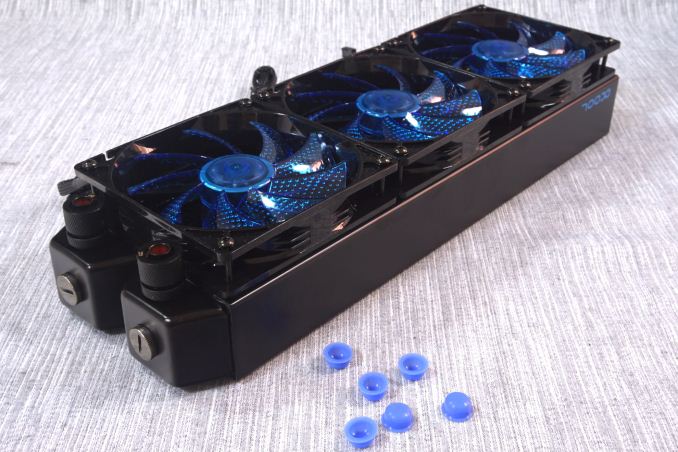
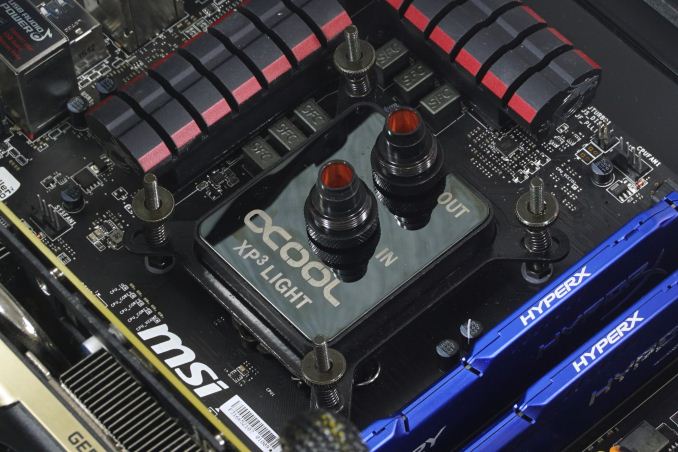
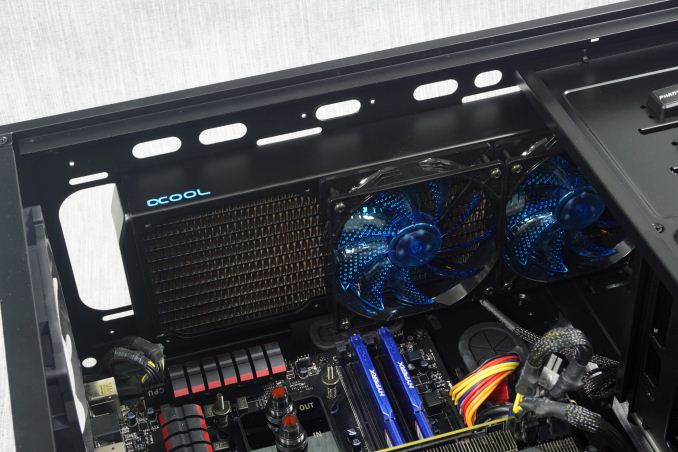
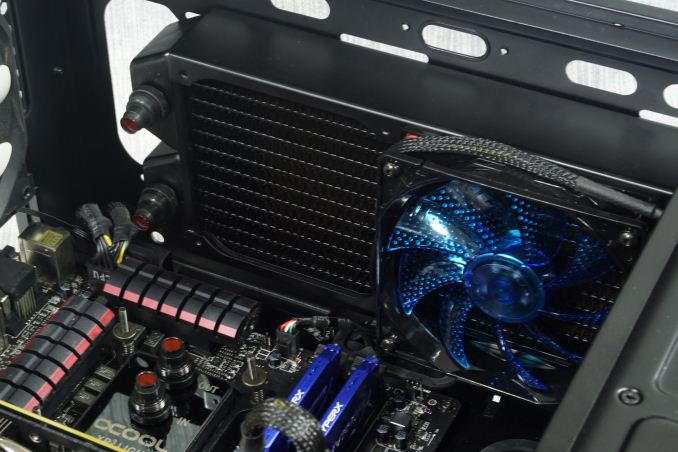
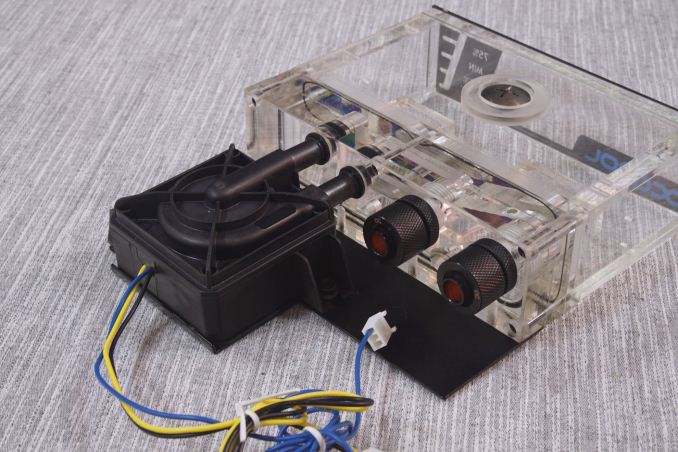
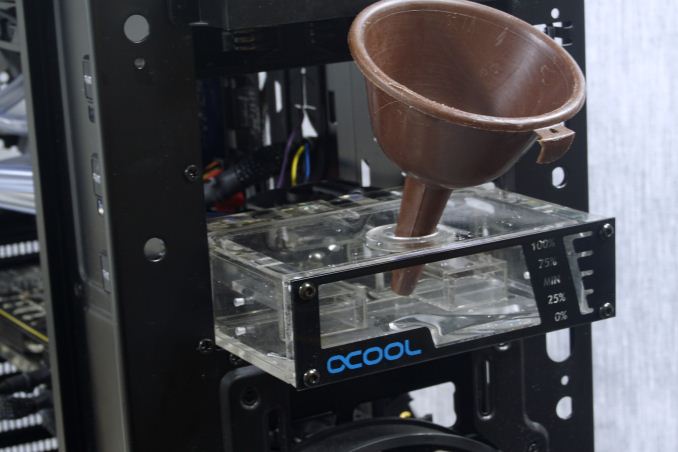









40 Comments
View All Comments
Death666Angel - Tuesday, October 25, 2016 - link
That works for people hard of hearing, those willing to put up with abysmall thermals and/or loud noise or those like you who have enough space and willingness to put the source of the noise in another part of their dwelling.BrokenCrayons - Tuesday, October 25, 2016 - link
That's a lot of exaggeration. Stock coolers are ear-splitting monsters that let the chip run at unsafe temperatures. There are literally billions of PCs that have been shipped with OEM coolers over the years and while a few designs have been fatally flawed (I'm looking at you ECS GREEN320 laptop with your whiny hair dryer blower on a 1GHz VIA C3 processor) the vast majority of them provide years of problem-free service by keeping the CPU within manufacturer specified temperature limits without causing undue end user stress due to poor acoustic design.Keep it in perspective. I'd happily agree that temperatures might be lower and the computer might be quieter with a bit of attention paid to cooling, but the way you're putting things seems overly dramatic.
HollyDOL - Monday, October 24, 2016 - link
I moved to custom loop to get rid of "angry vacuum cleaner" (back in 8800GT days). My pump is sitting in a foam inside the case and radiator is external, passive and quite big. In combination with noise dampening case and semi-passive PSU it's silent at city night (I guess in significantly quieter environment you could hear a bit but not really much).galta - Monday, October 24, 2016 - link
Liquid cooling is for people for want/need extreme performance, generating tons of heat in the process. Heatsinks that come out of the box cannot handle it.There is also the question of noise, for cooling an OCed system on air produces - generally - more noise than on liquid.
Those, however, do not seem to be circumstances that apply to you, so you better stay on air.
JoeyJoJo123 - Monday, October 24, 2016 - link
I'd clarify the "generally" part as follows:If they're using an AIO, chances are the combined pump + fan noise is actually noisier than a dual stack tower heatsink. (2x 120mm or 140mm fan + pump noise VS 2x 120mm or 140mm fans and no pump).
If they've built a custom open loop, then chances are that they've over-engineered the solution (as the few who go this route have the cash to spend and are willing to go all the way) and are using a thick radiator, a large reservoir, a large but quiet pump, and fans that don't ever need to spin up to address increased heat on intensive tasks, and at this point, they might actually have a quieter solution.
galta - Monday, October 24, 2016 - link
Lots of chances involved, it seems. In the end, what makes sense - generally - is to understand your problem and look for the best way to solve it.For some, air will do; for others, not.
Check Corsair's H110iGT review @ Guru3d: it is as quiet as the venerable Noctua NHD15, but 9C cooler when overclocking an i7 4790k. Oh, and it also significantly lighter than 1.32kg.
But then there is our friend BrokenCrayons, mixing bunnies with pancakes...
fanofanand - Tuesday, October 25, 2016 - link
I thought his points were valid and reasonable, far from mixing bunnies with pancakes.BrokenCrayons - Monday, October 24, 2016 - link
To steal a certain internet meme, "Overclocking in 2016 makes about as much sense as a bunny with a pancake on its head."Aerodrifting - Monday, October 24, 2016 - link
What's the point of running X99 i7 if you don't overclock? So you can be content with stock 3.0 speed?BrokenCrayons - Tuesday, October 25, 2016 - link
What's the poinnt of overclocking it? The home user's typical workloads don't benefit from overclocking and if they do, the increase in performance is marginal and not worth the effort. Sure there's showboating to friends and emotional self-gratification, but those aren't tangible rewards. If emotional satisfaction is what you gain from that sort of thing, then knock yourself out, but in my opinion, it's wasteful, childish, and silly.